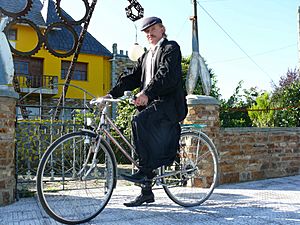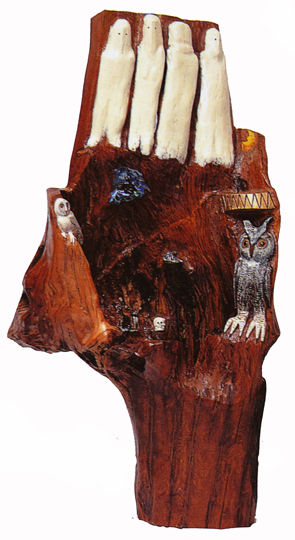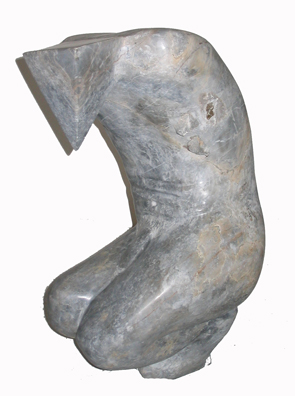Fernando Villapol facts for kids
Fernando Villapol Parapar was born on February 26, 1953, in San Tirso de Abres, Spain. He is a well-known Galician sculptor. He also works as a museum curator and art critic. Today, he lives and works in Bretoña, a town in Galicia.
Fernando Villapol started the Ethnographic-Pedagogic Museum in Bretoña. He studied art in Lugo, Spain. However, he mostly taught himself. He learned a lot about sculpture by traveling the world. He visited places like Africa, Cuba, Canada, and many countries in Europe.
Contents
What Materials Does He Use?
Fernando Villapol uses many different materials for his sculptures. He likes to work with:
- Metal: He uses strong metals like iron and bronze.
- Wood: He carves sculptures from various trees. These include common yew, oak, box tree, and chestnut wood.
- Stone: He also works with beautiful stones. These are often marble and granite.
What is His Art Style Like?
People who study art often describe Villapol's sculptures. They say his art can be realistic, abstract, or surreal. Sometimes, it's a mix of all three. He has been inspired by famous artists like Diego Velázquez and Salvador Dalí.
Recently, critics have said his style is unique. It's a blend of realism, abstractism, and surrealism. Villapol himself created a new word for his style: reabsu.
Critics haven't found one single style to describe my art. Most of them agree that my work mixes realism, abstractism, and surrealism. So, I took the first parts of these words to create a new one: reabsu. This word better describes my artistic style.
Awards and Special Recognitions
Fernando Villapol has won several awards for his amazing sculptures. Here are some of them:
- Arte de Meigas e Trasnos Prize (Sarria, Spain, 1990)
- Lugo Plastic Arts Award (Lugo, Spain, 1994)
- Cangas do Morrazo Prize (Cangas, Spain, 2004–2006)
- 1st prize in sculpture at the 10th Burela Art Competition (Burela, Spain, 2005)
- Luarca Arts award (Luarca, Spain, 2006)
The Ethnographic-Pedagogic Museum
Fernando Villapol founded and manages this museum. It opened in 2002. The museum shows a lot about rural Galician culture. It also displays modern Galician art.
You can see how different jobs evolved in the area. There are displays about clog makers, bakers, and carpenters. You can also learn about shoemakers, basket weavers, and farming.
The museum also has educational exhibits. These show what a typical Galician school looked like in the 1800s. There are also old doctor's, dentist's, and chemist's offices. The museum also has a large collection of over 2000 old Galician and Asturian soda syphon bottles.
Where You Can See His Art
Fernando Villapol's sculptures are part of several public collections. This means you can see his work in these museums:
- Provincial Museum of Lugo (Lugo, Spain)
- Ethnographic-Pedagogic Museum (Bretoña, Lugo, Spain)
- Museum of Fonsagrada (Lugo, Spain)
Selected Art Shows
Fernando Villapol has had many solo art shows. Here are some of the places where his work has been displayed:
- González Garcés Library (A Coruña, Spain)
- Provincial Museum of Lugo (Lugo, Spain)
- Museum of Fonsagrada (Fonsagrada, Lugo, Spain)
- Ateneo of Ourense (Ourense, Spain)
- Provincial Library of Lugo (Lugo, Spain)
- Esmelgar Gallery
- Almirante Gallery
- Bacabú Gallery (Lugo, Spain)
- Sargadelos Gallery (Vigo, Spain)
- Eiros Gallery (Meira, Spain)
- Solloso Gallery (Ribadeo, Spain)
- Taramundi Cultural Center (Taramundi, Asturias, Spain)
- A Guardia Cultural Center (Pontevedra, Spain)
- San Tirso Cultural Center (San Tirso de Abres, Asturias, Spain)
- Puerta II Gallery (Lugo, Spain)
- Cangas do Morrazo Cultural Center (Pontevedra, Spain)
- Grisolart Gallery (Barcelona, Spain)
- Magdalena Church in Rivadavia (Ourense, Spain)
- University of Sek (Segovia, Spain)
- Salnés Exhibition (Cambados, Pontevedra, Spain)
- El Vendrell (Tarragona, Spain)
- Vegadeo Cultural Center (Vegadeo, Asturias, Spain)
- Burela Cultural Center (Burela, Lugo, Spain)
- Alvaro Delgado de Luarca Gallery (Luarca, Asturias, Spain)
- Cajastur Bank Exhibit (throughout Asturias, Spain)
- Antique Museum (Paris, France)
- Pazo Melgaso (Portugal)
- Ribadeo Exhibition (Lugo)
See also
 In Spanish: Fernando Villapol para niños
In Spanish: Fernando Villapol para niños




